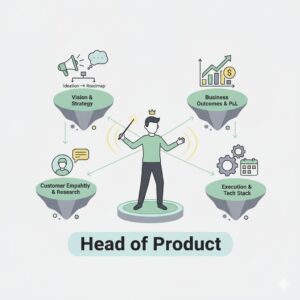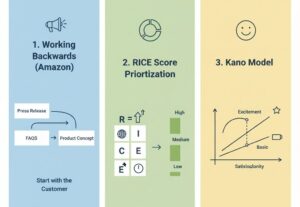During precisely 2011, Netflix had been transitioning from a DVD rental service to a very large-scale streaming service. It was Reed Hastings, the CEO, who made the strategic calls but, for a switch to streaming, the Head of Product was the one who ensured the seamless functionality of the platform for millions of users. Everything fell under product leadership: the interface design; personalized recommendations; and mobile experience.
Thus the story reminds us that between visionary directions and tangible outcomes, they occupy the head of products. In fact, without this vital role, even the boldest ideas remain on PowerPoint slides.
So what else does a head of product do, earn or become one? We are going to find out now.
What is Head of Product?
A Head of Product is a senior executive responsible for defining the overall product vision, strategy, and roadmap of a company. They lead product teams, align product goals with business objectives, and ensure successful product delivery and growth. They act as the orchestra conductor in that they may not play every instrument but rather synchronize engineering, design, and marketing teams to deliver truly beautiful products to customers.
The head of the product is different from all the other product managers who only concentrate on singular features. The head of the product, on the other hand, is tasked with a very broad area known as product strategy: everything from ideation to launch to iteration.

Some of the key aspects that describe the role:
- Holds the product vision and guarantees alignment with business targets.
- Coaches and manages product managers.
- Balancing customer needs and market opportunities.
- Skilful collaboration with the different executives: CEO, CTO, and CMO.
Simply put, if product management is about “building the right thing,” the head of product makes sure the company’s building the right kind of portfolio.
Evolution of the Role: Past, Present, and Future
Traditionally, the “head of product” has not always been a proper title. Back in the early 2000s, tech companies had a slew of product managers reporting directly to the CEO. The emergence of an organization size that demands a dedicated leader can no longer be avoided.
As we speak, it is one of the most strategic positions in technology companies. Tomorrow, the title may become more specialized: “Head of AI Product” or “Head of Sustainability in Product.”
Head of Product Job Description
A normal job description of a head of product includes:
- Ownership of Strategy – Define long-term product roadmaps and prioritize what matters regarding features.
- Leadership – Recruit, coach, and grow the product management team.
- Cross-Functional Collaborative – Act as an enabler between engineering and design toward sales and marketing.
- Consumer Obsession – This will keep one within close proximity to customer pain points through research, interviews, and data analytics.
- Execution Oversight – Ensures that deadlines are realistic and budgets are respected while maintaining quality.
- Market Awareness – Keeping an eye on competitors, trends, and emerging technologies.
Going the extra mile beyond that really does not mean just shipping features. It creates a picture of how the organization competes and grows with its market.
Strategic Frameworks: The Head of Product’s Toolkit
The central part of the head of product management role is to go beyond mere feature prioritization. They must employ some established strategic models to come up with the high-stakes decisions. Knowing these models is a hallmark for a paid head of product salary. These are not academic concepts: they’re actual decision-making shortcuts.

- Working Backwards (The Amazon Method): Before a line of code is written, the HoP needs a full internal Press Release and FAQ document. One time, I had a team write a brilliant press release for a product that we then went on to decide not to build. Most expensive lesson we ever had. This forces the team to articulate the customer benefit and the launch success criteria first, ensuring that they build the right thing.
- The RICE Score: While individual features are the core business in the PM world, HoP scores product lines or strategic themes against one another. Also compares areas of return on investment across the business. It’s basically your sanity check against the HiPPO.
- The Kano Model: This engages features into three areas: basic (must-have), performance (more is better), and excitement (delighters) and thus manages customer expectations accordingly. The HoP, therefore, balances the roadmap between all the three categories, with budgets built in for “delighters” for keeping the competitive edge going. To stay alive, I need a few “delighters” every year. That’s the spark that keeps customers talking about you.
Head of Product vs Other Product Leadership Roles
Many people might wonder, what exactly is this role in the bigger picture of leadership?
- Head of Product vs. Director of Product: Often, a director leads a department but reports into the head of product. The latter has broader, company-wide authority.
- Head of Product vs. VP of Product: Title often gets confused. Some companies put the VP on higher ground, while others consider them equal in rank.
- Head of Product vs. CPO (Chief Product Officer): In a lot of instances, the CPO is termed toward an executive-type role. The head of product may eventually evolve into this position as the company scales.
Titles vary from company to company, but essentially, the head of product manages the entire product portfolio and not just bits and pieces of it.
What does Head of Product Management Job Look Like?
Consider a startup launching a fintech app.
The whole idea of a CEO goes like this: “A platform that helps millennials save smarter.”
The Head of Product puts into reality what that vision means by:
- Creating user personas.

- A set of features (automated savings, gamified rewards, budgeting insights).
- Prioritizing launch features from those that may just be nice to have but aren’t necessary.
- Giving guidance to product managers in terms of iterations.
They’re like air traffic controllers: all planes (features, teams, deadlines) land without crashing into another.
Career Path: How Do You Become a Head of Product?
Unlike some careers with clear rungs on their ladders, product leadership is mostly nonlinear. This is, however, the most common pathway.
- APM: Associate Product Manager – Learn user research basics, requirement-writing, and how to ship features.
- PM: Product Manager – The specific feature or small product is the responsibility of ownership.
- Senior Product Manager: Higher scopes, mostly cross-functional team-based.
- Director of Product: Oversee multiple PMs, set roadmaps, influence executives.
- Head of Product: Lead the product org, owns the company-wide product vision.
Along the way, great heads of product build extreme business acumen, leadership skills, and technical literacy. It is more than just knowing “users”—one needs balance sheets, data pipelines, and market forces.
Head of Product Salary: How Much Will You Make?
A head of product’s salary significantly varies from one geography, company size, and industry to another. One thing, however, remains constant: it is among the highest-paying jobs in the entire product world.
- United State: $180,000 – $250,000 per year, besides equity bonuses.
- United Kingdom: £100,000 – £140,000.
- India: 50 to 90 lakhs per year with the top tech firms.
While salaries may generally be lower for remote-first startups, they are often balanced out with the inclusion of equity.
That speaks volumes about the fact that this role marries strategic vision to operational responsibility. After all, companies know that a fantastic head of product can make or break their competitive edge.
Why Companies Value the Head of Product Role
Let us be frank: some time, a company can do without a CMO or a COO, but there is no way to grow without great product leadership.
Why? Because, in most industries, products are the company. For Spotify, the product is the business. For Tesla, the car is the product. For Amazon, the product experience (fast delivery, recommendation engine) drives loyalty.
The head of product ensures:
- Teams do not only build. They build what should be built.
- Consumers are made to feel heard, not ignored.
- Evolving the strategy of the company with the market, not against it.
Without this role, the characteristics of a “feature factory” are represented by “shipping a lot but accomplishing little.”
Building Your HoP Resume
The HoP role is earned through results rather than time served. This section gives guidance on compiling a portfolio that demonstrates the readiness needed for the role.
- Beyond the Feature List: Stop writing features that you shipped most recently and start putting those business outcomes you drove. Rather than “Launched new dashboard,” say: “Increased B2B user retention by 15 percent through the launch of a custom analytics dashboard aligned with the new sales strategy.” .
- The Strategy Document: Examples of high-level planning documents you authored should also include a market sizing analysis, competitive teardown, or three-year product vision. This would prove you ideally operate at HoP’s required altitude.
- Mentorship as Leadership: Capture that experience of coaching junior team members or leading cross-functional task forces. The ability to grow talent is a mandatory part of the head of product management job.
The Executive Interview
Getting appointed as HoP means getting to impress CEOs and Board members during interviews, people who generally have vastly different focuses when it comes to high-level strategy and finance.
- Know Your P&L: Be ready to speak to how your product impacts the business from Customer Lifetime Value (CLV), Customer Acquisition Cost (CAC), and Product Margin. The Head of Product salary reflects direct responsibility for the financial weathering of the product.
- The Product Strategy Challenge: You will be given an ambiguous business situation (for example,” Our largest competitor just undercut our price by 50%”). Your answer needs to be structured with data defined trade-offs-never jump to solutions.
- Culture & Organizational Fit: Have an understanding of the company’s current product culture as well. Are they a “feature factory” or a true product organization that’s strategic? Articulate how you are going to lead them toward the next level of product maturity.
Technology Stack: Tools for Product Management
This new Head of Product job requires building an open, efficient product organization. It involves selecting and managing a tool stack to connect strategy with execution. The HoP acts as the buyer and architect of this stack, placing visibility and data flow over individual depth of feature value.
1. Strategic and Roadmapping Tools
The HoP will use them to relay the Why and When to executive teams and the market.
Productboard / Aha! / ProductPlan: Will centralize customer feedback, provide a multi-quarter roadmap, and link specific initiatives directly to high-level OKRs (Objectives and Key Results).
Miro / FigJam: Virtual whiteboards for high-level cross-functional strategy sessions, ideation, and mapping out very complicated user journeys with design and engineering leads.
2. Product Analytics Platforms
This is the HoP’s nervous system-how they keep their fingers on the pulse of the business and understand whether the return on investment on the entire head of product salary works.
Amplitude / Mixpanel / Heap: Track user behavior (clicks, funnels, retention) at a granular level. The dashboards will allow the HoP to discover systemic product issues, not simply local bugs.
Data Warehouse (for example, Snowflake or BigQuery): This isn’t a PM tool, but the HoP works with the CTO to make sure that product data resides in properly compiled warehouses and models to ensure full Trustworthiness in all reporting.
3. Execution and Development Tools
These tools are then defined under the HoP on how these tools will be used by the product org to ensure predictable delivery and clear handoffs to engineering.
Jira / Azure DevOps: The HoP ensures that there is a standardized workflow (Agile/Scrum/Kanban) throughout the organization via these tools, making progress transparent right from the CPO down to the individual contributor.
Confluence / Notion: These are the platforms overseen by the HoP, designed to be the center of truth for all product documentation such as specs, release notes, and long-term research.
Common Challenges Heads of Product Face
This job isn’t all riveting strategy meetings. Some challenges include:
- Balancing immediate vs. distant considerations. Invest in a small revenue-driving feature now, or take a bigger bet on something that would yield in the long run?
- Managing expectations from top executives. While the CEO may want everything to be built at once, the head of product must set a priority without mercy.
- Scaling teams. Hiring PMs is only half the battle. Creating a culture where data is lovingly embraced to make decisions becomes an endeavor.
- Whose needs – customer or business? Oftentimes, customers want things they do not see the utility in paying for, forcing the heads of product to handle an art of gnawing tension.
This great head of product sails through these with a combination of diplomacy, data, and just being decisive.
Skills Every Great Head of Product Needs
Should this be the role you aim at, these are the must-haves:
- Strategic Thinking – Sitting above the constellation and seeing far with respect to company growth going through the roadmap.
- Leadership and Management of People – Building a diverse product team, mentoring, coaching, and motivating from within.
- Analytical Mindset – Comfortably seated with data, KPIs, and financial valuation models.
- Technical Literacy – Not to code, but able to speak engineering with something of an accent.
- Communication Skills – Breaking down complexity for stakeholders and getting teams rallied.
- Customer Empathy – Defining success on the basis of user adoption and satisfaction.
Examples of Real Product Leaders in Action
- Amazon: The recommendation engine is famous, but by its side were heads of product ensuring that personalization matched well with business goals.
- Spotify: The “Discover Weekly” playlist did not happen by chance; it was a result of product leaders advocating for a personalized musical experience.
- Tesla: The company has changed what customers can expect from an industry through product leadership with features such as over-the-air updates.
These cases showcase how heads of product drive not just internal roadmaps but entire industries.
Future of the Head of Product Role
The product world is changing fast. In the near future, heads of product will not only take care of software; they will manage AI platforms, connected devices, and immersive experiences.
The trends that will characterize this role include:
- AI Responsible Roadmap – Heads of product will decide how responsibly AI will fit into roadmaps.
- Sustainability Responsible – Green tech and ethical design are now becoming inescapable.
- Leading Global Teams – With remote work is a reality; they’ll be leading product orgs through time zones.
- Product-Market-Customer Success Blurring – The lines between product, market and customer success will keep on getting blurred.
In many ways, the role is transforming into a mini CEO of the product organization.
Learn with PW Skills to Fast Track Your Career in Product
Strong foundations of product leadership actually begin with an understanding of design. PW Skills’ Product management course with AI arms you with practical knowledge in addition with AI tools. If your ambition is to become a product manager or one day head of product, learning AI-PM tools and deep insights in this course will give you a leg up in the creation of user-centered products.
Yes. The head of product manages multiple product managers and sets the overall product strategy, while PMs handle specific features. Not at the earliest stages. Startups with fewer than 10 people often have the CEO acting as the product head. The role becomes essential as teams grow. Tech companies dominate, but industries like fintech, healthcare, retail, and manufacturing also rely on product leadership. Most come from product management, but some transition from engineering, design, or business strategy roles.FAQs
Is Head of Product higher than Product Manager?
Does every company need a head of product?
What industries hire heads of product?
What’s the typical career background for a head of product?

